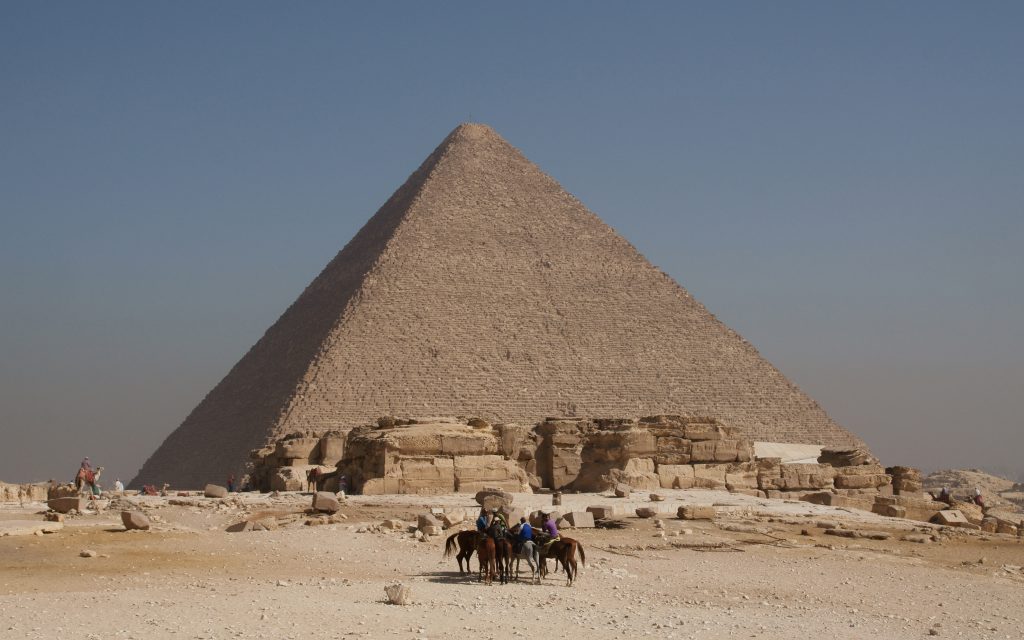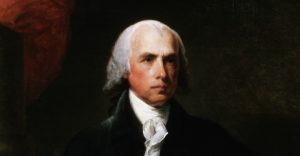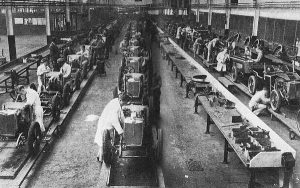The construction of the Great Pyramid of Giza has been a great mystery for many centuries. Recently, archaeologists believe that they have found evidence that suggests that it was not slaves, under the order of King Khufu, who were responsible for building the pyramid. With the discovery of nearby mastabas, there is now substantial evidence suggesting that normal villagers would periodically help construct the Great Pyramid, and they were motivated by their religious beliefs.1
King Khufu is considered one of the greatest rulers of his time, largely due to the elaborate pyramid he was able to create during his lifetime. He was known as a cruel and tyrannical leader, but was evidently powerful by being able to gather a large workforce and enough materials to construct the Great Pyramid, most of which is still intact today. According to Greek historian Herodotus, there had been around one hundred thousand slaves working through King Khufu’s reign. This was proved false in 1990 when the archaeologist Zahi Hawass discovered a town of mastabas near Giza.

These mastabas were rectangular mounds made of mud bricks. Eventually, they would stack some of them together to form pyramids, giving them the idea of the modern pyramid. The findings of many mastabas suggests that the workers were not slaves but were actually compensated in some form for their labor. They also discovered two miniature pyramids that held the remains of officials, such as supervisors, technicians, and craftsmen on the upper level, and other laborers on the lower level.2 The workforce consisted mainly of peasant farmers who would work during the fall and winter seasons. During that time period they were unable to work on their farms due to the seasonal overflow of the Nile River. This gave them an opportunity to continue working throughout the year. It was also a great way for the peasant farmers to get food, clothing, and shelter.3 Some laborers took part in a group called a phyle, which was a rotating group of workers who would work for a month. The king would collect surplus crops as well as other clothing to distribute to these workers, which he levied as a form of tax. Egyptologist such as Zahi Hawass and Mark Lehner now estimate that only about twenty to thirty thousand men were needed to build the Great Pyramid.
The construction of the pyramid was a communal project in which all Egyptians took part, including women as well as men. At the time, there were no machines or animals to help carry the loads of limestone and granite to the pyramids.4 Every block was handmade and crafted to fit perfectly alongside the other pieces. They cared greatly in their work and took pride in their accomplishments. Not only were they building the burial site for their king, but they were also taking part in the construction of a new and elaborate Egypt.
During Egypt’s Old Kingdom, when these pyramids were built, the kings were associated religiously to gods. They were seen as the living manifestation of the god Horus, the god of the sky. The god Horus was also the son of Osiris, who was the king of the underworld. Once the king would pass away he would become one with Horus.5 This helped motivate the laborers to continue building the pyramids. Most Egyptians at that time were very religious and spent their life preparing for what would come after death. They believed that by building the pyramid for their king, a descendant of Osiris, they would assure both their king and themselves a good afterlife. Because of this, they did not see their work as a continuous strain, but rather viewed it as an honor.
Overall, it was a very organized and coherent system that allowed everyone to partake in. It was beneficial not only to King Khufu, but to the entire Egyptian society as well. Jobs were created and many peasants received benefits of clothing and shelter from the enterprise. It united the Egyptian civilization and created magnificent pyramids that we can still visit today.
- Mastabas are burial mounds that were used to bury rulers and pharaohs, which later gave way to the idea of a pyramid. See Global Events : Milestone Events throughout History, Vol 1. Africa, Jennifer Stock, ed. (Detroit : Gale, Cengage Learning, 2014., 2014), 12. ↵
- Global Events : Milestone Events throughout History, Vol 1. Africa, Jennifer Stock, ed. (Detroit : Gale, Cengage Learning, 2014., 2014), 18. ↵
- The Oxford Companion to Archaeology (2 ed.), 2012, s.v. “Pyramids of Giza,” by Edward Bleiberg. ↵
- The Oxford Companion to Archaeology (2 ed.), 2012, s.v. “Pyramids of Giza,” by Edward Bleiberg. ↵
- Funk & Wagnalls New World Encyclopedia, 2016, s.v. “Horus”. ↵



87 comments
Clarissa Bustamante
It amazes me that the pyramids were built on religious foundations. I appreciate that this article tells us the true facts. I figured that slave were the original people who built the pyramid, but this article explains so much about things I did not know! This article has given me a different view about the production of the pyramids.
Karina Nanez
This is an interesting article because more often than not people just assume that these great architectural builds were made by slaves, but this goes to show that regular everyday citizens wanted to participate in great architectural build like this because it was seen as a great honor rather than a horrible burden. Before this I hadn’t known that they had made little pyramids from them to be buried in either, how interesting.
Rafael Azuaje
I wonder if there are other things that we believe about ancient societies that will change in the future. This reminds me of another article that claimed the builders of the pyramids were given vast amounts of beer as part of their payment. I wonder if some people nowadays would accept part of their payment that way.
Maybe they would if the beer was good enough.
Sam Vandenbrink
Great article! I learned more in depth about how and why the egyptians made temples and even though they look like the tombs there actually active temples with worship going on inside. The temples looks more like a place of worship then barrel grounds to begin with. It makes much more since that they would be a temple then a tomb with the design. great article very in-depth.
Tara Sellers
I have heard of the Great Pyramid of Giza, but I did not know much about it. I had heard that slaves had most likely help build the pyramid. It surprises me that common people helped build the Pyramid. However, it does makes sense if they could not work on there farms due to flooding that they would find other work. Also, the fact that they believed their Kings would turn into gods after death made them want to build the pyramids.
Joel Gracia
This article provides such an interesting perspective of the Great Pyramid! I have been interested in the subject since elementary school, in which I did research projects on how the structures came to be. That is why this article caught my attention. Maybe it was my poor 5th grade research, but I had always thought that the building of the pyramids was an unjust use of power from the pharoah. But, the way this article speaks about the process makes it clear that it was a unifying and inclusive experience for the community, which is such an important view that too often goes unacknowledged.
Faisal Alqarni
Hi Diana, I really was surprised to learn that th Great Pyramids of Giza were not built by slaves I was taught by my religion that it is so and I guess I have believed so. To find out that in the 1990’s it was proved to be different is really a game changer for me, I guess it just contributes to the conflict of science vs. religion. To find out that such a big monument was built voluntarily by a group of humble villagers (the Mastabas) to me just shows how when people come together under a common purpose thy can achieve such great things.
Ana Gonzalez
Great article! I have always assumed that pyramids were built by the enslaved population of a civilization because it sounds like it is a cruel and harsh working environment. However, you presented a whole other view to how these pyramids were actually built. Your article was well-written and organized. Great job! I would’ve never thought that civilians would actually volunteer to work on these pyramids and that everyone would peacefully cooperate. Talk about team work, great job!
Johnanthony Hernandez
Great article, not many people know that the pyramids weren’t built by slaves but by Egyptian citizens. I did not know that they built them during the Fall and Winter months because of the rising of the Nile during that point or that they were paid with food, clothing and shelter during the time that they worked on construction of them. I had done some prior research on the construction of the pyramids but your article makes me want to dive a little deeper into how they were built.
Priscilla Reyes
Great job with your article! The pyramids are something that I, too have looked, because of the interesting motives behind their practices. I really liked that you dwelled into the different positions they could be given in the process and to what they did while they weren’t building the pyramid. I believe the civilizations religious beliefs did influence their practices! Having written an article, myself on the different motives to create, the belief of preparing for the afterlife was popular throughout my research. They also believed it affected their society.